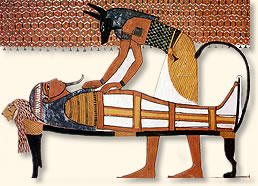|
Making an Ancient Egyptian Mummy
The ancient Egyptians believed that, after death,
the body was the home of the individual's spirit as he or she journeyed through
the after-life. If the body was destroyed through decomposition, there was danger
that the spirit would also be destroyed. Preserving the body in as close to its
life-like condition would assure the preservation of the individual's spiritual
essence. "Mummification," the process of preserving the integrity of an individual
through embalming the body of the deceased, was the ancient Egyptian answer to
the problem.

A wall panel from an Egytian tomb
depicts the god of mummification at work. |
It is believed that the process of mummification was developed at least 2,500
years before the birth of Christ. The process included four phases: the removal
of the internal organs, the use of a salt compound to dry the hollow body, filling
the dried body with a stuffing to restore its original shape and finally, tightly
wrapping the body with strips of linen. Although expensive, the process of mummification
was not restricted to the Egyptian Pharaohs. All of the social classes employed
the ritual, with the level of elaborateness of the mummification serving as a
symbol of a family's status.
The Greek historian Herodotus described the ancient Egyptian methods of mummification
around the year 450 BC. Although over two thousand years have past since Herodotus
wrote his observations, his description of the relationship between the ancient
embalmers and the grieving relatives of the deceased bears an uncanny resemblance
to today's interplay between a funeral director and a grieving family selecting
an appropriate coffin or other method of internment.
"The embalmers, when a corpse is brought to them, show the relatives wooden models of dead bodies, as accurate as a painting. They say that the most perfect of these images belongs to a god whose name I consider it sacrilege to mention in this connection. They also show a second, slightly inferior to the first and less expensive, and a third as well, the cheapest of the lot. After the demonstration, they ask the relatives in which style they want the corpse prepared. The latter agree on a price and go off home, but the embalmers stay in their workshops and use the following method for the most expensive style."
"First, they remove the brain through the nostrils with a curved iron implement, getting some of it out like this and the rest by pouring in solvents. Then they cut open the side of the corpse with a sharp Ethiopian stone, remove the intestines, and wash out the belly, cleaning it with palm wine and again with pounded aromatics. They fill up the body with pure crushed myrrh, cassia and other herbs (except frankincense) and sow it up again. After this, they pickle the body in natrum, [salt] hiding it away for seventy days, the longest time possible. After the seventy days, they wash the body and wrap it up completely in cut bandages of linen muslin, smearing it with gum which the Egyptians use instead of glue. The relatives then get the body back and make a man-sized wooden image, into which they insert the mummy and then store it away in a burial chamber, standing it upright against the wall."
"That is the most expensive way. The method for those wanting the middle way, to escape great expense, is as follows. They pack syringes with cedar-oil and fill the stomach of the corpse with the oil, not cutting it open and taking out the intestines, but inserting the oil through the anus and stopping it flowing out. Then they soak the body in spices for the prescribed number of days, on the last of which they remove from the belly the cedar-oil which they put in before. This has such strength that it brings out with it all the dissolved stomach and intestines. The natrum dissolves the flesh and only the skin and bones are left. When this is over, they return the body, their job completed."
"The third method of embalming is the one used by the poorer classes. They just wash out the inside with a solvent, then pickle it for seventy days and return it to the relatives."
References:
This eyewitness account appears in: Workman, B.K. (ed.), They saw it Happen in Classical Times (1964); Romano, James E., Death, burial and afterlife in ancient Egypt (1990); Spencer, A. Jeffery, Death in Ancient Egypt (1982).
How To Cite This Article:
"Making an Ancient Eyptian Mummy" EyeWitness to History, www.eyewitnesstohistory.com (2008).
|






